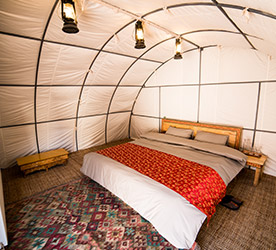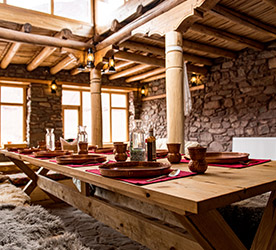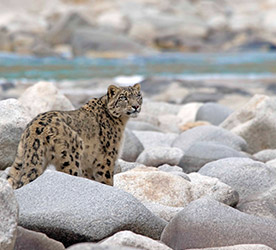
MONTHLY MUSINGS
The Land of High Passes

Situated in the western end of the Himalayas, Ladakh is an extension of the Gobi Desert and the Tibetan Plateau which has some of the world’s highest and harshest terrain. The word ‘Ladakh’ literally translates to the Land of the High Passes and in the Himalayas, which stretches from the Karakoram in the west to the Namche Barwa in the east, across five countries - India, Bhutan, Nepal, China, and Pakistan – these high passes are the stuff legends are made of. From Alexander of Macedonia, celebrated Chinese travellers such as Fahien and Huen-Tsang, Atisha the Buddhist Monk of Bihar who carried the world of the Buddha across Asia, to traders on the fabled Silk Route - saints and sinners alike have moved through these formidable passes that are still considered as sacred spaces.
In Buddhism, it is believed that whenever you cross a high pass in the Himalayas you should let your eyes gaze into the sky with complete awareness, stare straight into the middle of the sky and shout “ki ki so so lha gyalo”(meaning victory to the Gods). This practice is still religiously followed by all Ladakhi taxi drivers during the journey from Manali to Leh where one has to cross four such high passes.
Leh is the joint capital and one of the two districts of Ladakh. For centuries Leh was an important stopover on trade routes along the Indus Valley between Tibet in the east, Kashmir in the west, and also between India and China. The journey through large stretches of stark high altitude cold desert, on horses and foot, was so treacherous that there used to be a local saying in Ladakh that you got to be the best of friends or the worst of enemies to embark upon it.
On 24 May 1948, a Dakota DC-3 transport aircraft landed in Leh with much-needed reinforcements for the desperate Indian Army garrison with just 33 men. This was a momentous event that helped India retain a vast portion of the Ladakh region by repulsing the tribal raiders supported by the Pakistani Army. The makeshift airstrip was built in a record time of two months by a young and enterprising Ladakhi engineer named Sonam Norbu, braving the most challenging conditions of the harsh winter. Some of the locals still fondly recall how even before they saw a bicycle, or for that matter any vehicle, they witnessed the landing of an aircraft which they thought was a flying horse. This inaccessibility has helped preserve a traditional way of living and Buddhist culture which is the highlight of a visit to the Ladakh region.
Leh and Ladakh, contrary to popular perception, now have some beautiful, charming, comfortable, and even luxury properties. Delhi and Mumbai have daily non-stop flights to Leh round the year. A stopover of at least two to three days in Leh is advised for total acclimatisation before embarking on any activities should one take a flight to Leh.
WHERE TO STAY

Lchang Nang Retreat, Nubra
Set against the backdrop of the Karakoram Range, Lchang Nang takes its name from the twenty-five acre orchard of Elm, Apricot, and Apple trees nestled on the banks of Nubra River. Owned by a Ladakhi family who lived for generations in Teggar village, the Lchang Nang was conceptualized based on their reverence for the past, with an eye to the future. Also known as ‘The House of Trees’, this beautiful low-impact resort is totally solar-powered and adheres to sustainable practices such as providing filtered glacial snowmelt for both drinking and bathing, as well as reducing use of single-use plastics. Seventeen traditional Ladakhi style cottages are sprawled across seven acres of verdant grounds, joined by trickling gullies and vibrant flora. The menu is an ever-changing choice of regional delicacies.
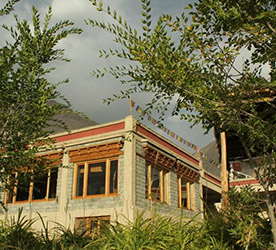


Stok Palace, Leh
Built in 1820, Stok Palace is a living palace that has been transformed into a small all-suites heritage property. Perched on a hill with magnificent views of the Indus Valley, the Stok Palace continues to be the cosy abode of the Namgyal royal family. This 200 year-old palace, located about half an hour away from the Leh airport, features exquisite Ladakhi architecture, décor that recalls the region’s rich culture, and artefacts that vividly captures the lifestyle of the royal family. The four-storied heritage structure features the royal apartments, prayer chambers set around interlinked courtyards, and large decorative projected balconies. The suites are non-air-conditioned and are spread across different levels of the palace. The rooms are completely devoid of WiFi, television, or intercom, allowing guests to disconnect from the rest of the world for the duration of their stay. For those seeking ultimate privacy, Stok Palace also offers three private villas handmade from wood and mud nestled amidst old apricot, walnut, and willow trees. Guests have exclusive access to the Museum, the Lhakchung Temple, as well as the opportunity to enjoy breakfast on the palace rampart, and dine in the restored Old Royal Kitchen.



Nimmu House, Ladakh
Nestled at an altitude of 10,000 feet in the heart of the mighty Himalaya, Nimmu House is a noble house turned into a charming heritage eco-retreat. A little piece of heaven on earth, Nimmu has been restored with stripped-poplar floors, exposed beams, chalk-white walls, and bright Himalayan textiles preserving the local heritage while keeping authenticity as the central theme. The five exquisite rooms in the main building are soothing, and sophisticated yet traditional, while the seven luxury tents scattered around the orchard offer all the modern comfort with a view of the garden. Immerse into the local culture and connect with the nature, while staying in incomparable comfort in this isolated Himalayan region.


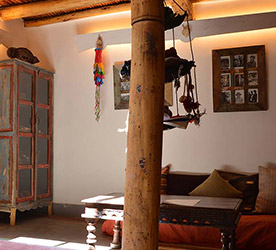
The LUNGMĀR Remote Camp, Ladakh
Nestled deep in the Trans-Himalaya of India, beyond medieval Tibetan Buddhist Monasteries and past ancient shepherding hamlets, their spectacular location, and timeless Silk Road feel strike the perfect balance between remote luxury and rugged adventure. With one of the best snow leopard tracking teams on the planet, it is a peerless wintertime experience. The centrally-heated property has two luxurious geodesic dome suites, six beautifully appointed standard tents, and an incredible restaurant.

